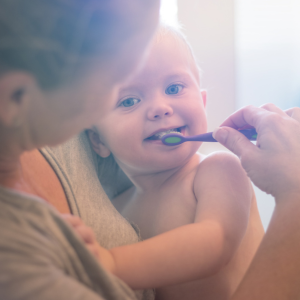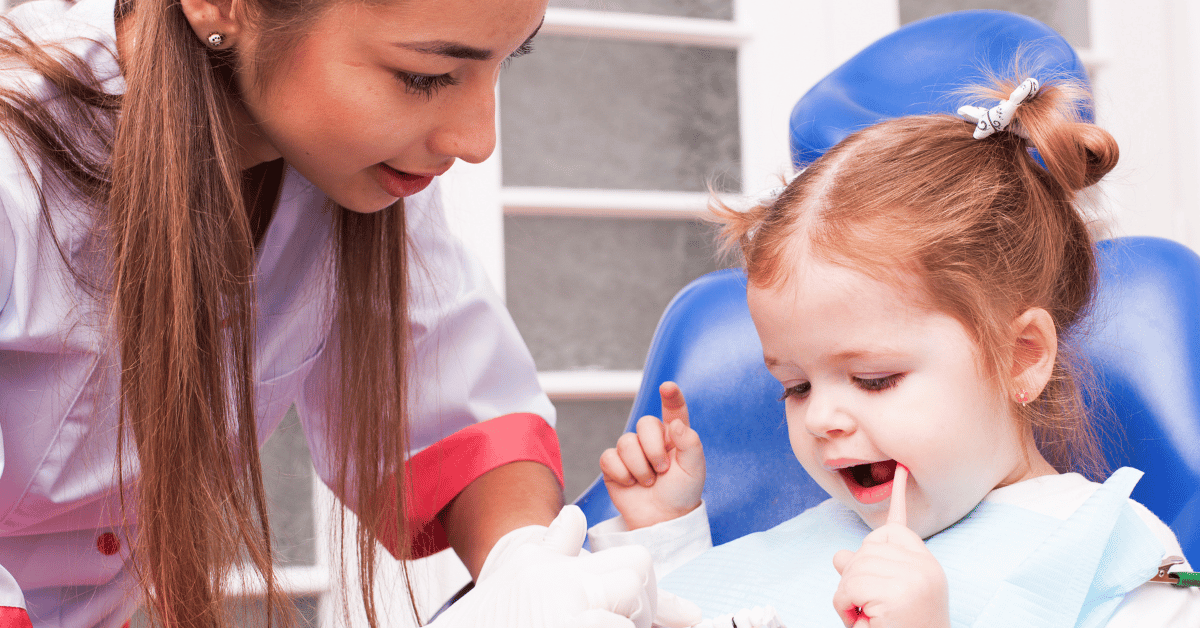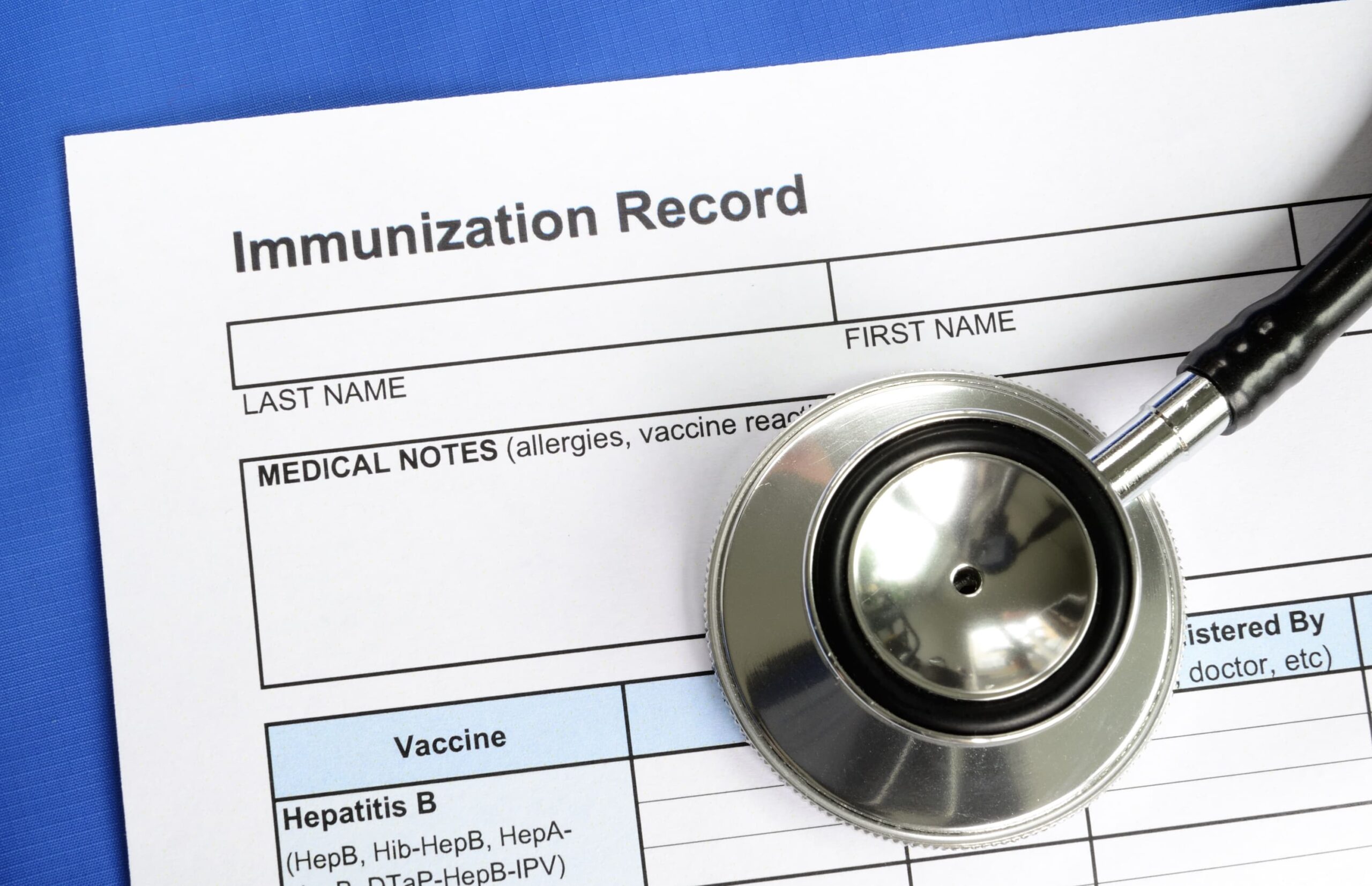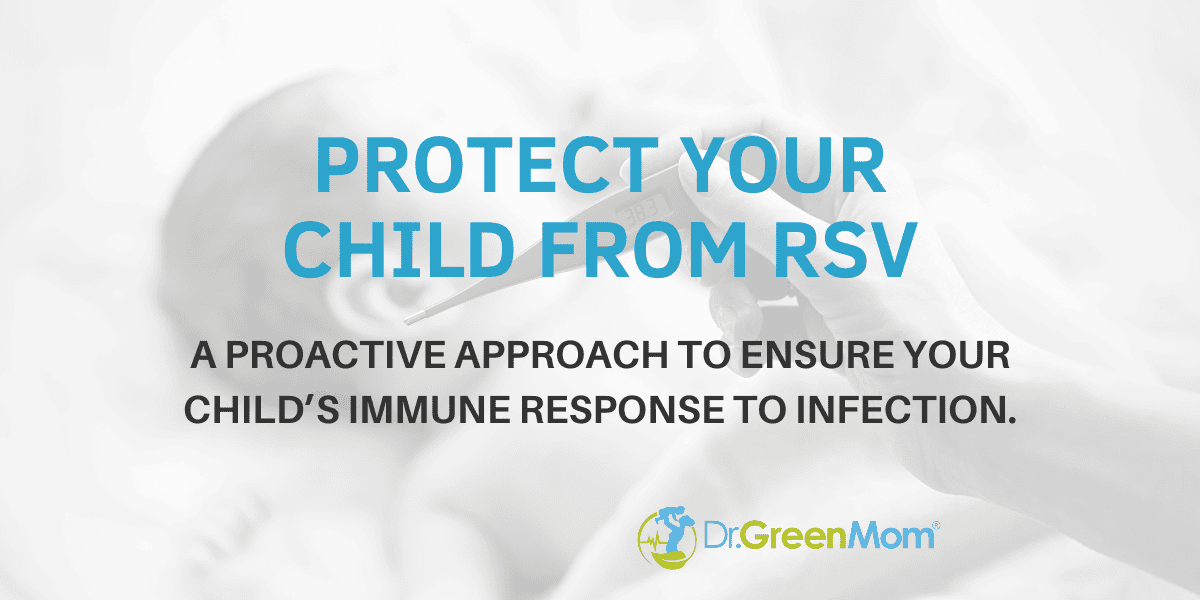Introducing proper dental care in the early years is important for your toddler’s health. This article explains the importance of toddler dental care, providing a look at why early dental hygiene is required for overall health, how parents can ensure their toddler’s teeth remain healthy, and the benefits and concerns regarding fluoride, hydroxyapatite, and dental sealants.
The Importance of Early Dental Care for Toddlers
Early dental care lays the foundation for lifelong oral health. Dental decay is the most common chronic disease in young children (1), but it is largely preventable with early and consistent dental care. It is important to start out young with implementing good dental habits. The research increasingly supports the connection between oral health and overall health (2).
 Studies have demonstrated links between periodontal disease and cardiovascular issues (3), suggesting that inflammation in the gums may contribute to heart disease. Research also suggests a potential connection between chronic oral infections and dementia (4) as well as certain types of cancer (5).
Studies have demonstrated links between periodontal disease and cardiovascular issues (3), suggesting that inflammation in the gums may contribute to heart disease. Research also suggests a potential connection between chronic oral infections and dementia (4) as well as certain types of cancer (5).
This growing body of evidence underscores the importance of maintaining good oral hygiene, not just for preserving dental health, but as a component of overall well-being. While the development of diseases are usually less relevant during early childhood, the toddler years are an optimal time to lay the foundation of good dental hygiene and health that will last a lifetime.
At What Age Should I Start Brushing My Child’s Teeth?
Dental care should begin even before a baby’s first tooth appears. Parents can clean their baby’s gums with a soft damp cloth a few times a day to help get their baby used to the sensation of toothbrushing. As soon as the first tooth appears, it should be brushed twice a day with a soft-bristled toothbrush.
If desired, a small amount of age appropriate toothpaste can be used; the CDC recommends waiting until age 2 to use fluoridated toothpaste (6). (More on this soon!)
Daily Brushing & Flossing: Techniques & Tips
As your toddler gets older, and more teeth emerge, effective brushing and flossing become even more important in preventing tooth decay and gum disease. It is important to be aware of what constitutes effective tooth brushing for toddlers.
- Brushing: Use a small soft toothbrush designed for toddlers. Place the brush at a 45-degree angle to the gums and gently move it back and forth in short circular strokes. Brush the outer surfaces, inner surfaces, and chewing surfaces of the teeth. There is no need to push hard, and the bristles should not be bending or compressing much at all. If the toothbrush looks frayed after several uses, you are applying too much pressure.
- Flossing: Flossing can remove plaque and food particles from between the teeth and under the gum line where a toothbrush cannot reach. It is recommended to begin flossing once any two teeth touch each other. However, for many toddlers, who still have plenty of space between their teeth, early flossing can offer the benefit of creating the habit and expectation of regular flossing.
- Rinsing: Most toddlers aren’t very good at rinsing and spitting, but they can certainly practice. Some dentists say that it may not be necessary to rinse because leaving the toothpaste in the mouth allows for more contact time with the enamel. However, it is important to consider that if your toddler isn’t rinsing and spitting very effectively, they are consuming the toothpaste and all the ingredients in it.
The reality is that this is often easier said than done. Toddlers are notoriously strong-willed. In order to make toothbrushing an enjoyable experience for all, I recommend singing funny songs, letting your child brush your teeth first, and giving your child a turn to practice brushing as well. Another tip is to act like you are on a scavenger hunt and use your toothbrush to look for crumbs in their teeth. Silliness wins over being forceful, and it’s important to keep in mind that we are laying the foundation for a lifetime of good dental health, so it’s worthwhile to make the experience a joyful one.
Your Child’s First Dental Visit
The American Academy of Pediatric Dentistry recommends that children have their first dental visit by the age of one or within six months after the first tooth erupts (7). This visit is important for a few reasons:
- Assessment of Growth and Development: The dentist will assess the development of the child’s teeth and jaw, identifying early signs of potential issues.
- Parental Education: Dentists provide guidance on proper brushing techniques, dietary suggestions, and habits to avoid that may harm the child’s teeth, such as prolonged bottle-feeding.
- Preventive Care: Dentists may recommend the application of fluoride varnish and there may be discussion about the use of dental sealants as teeth grow. Many parents have concerns about these approaches, and I always recommended asking questions and doing your research. Below, you will find more information on fluoride and dental sealants.
After the initial visit, regular checkups should be scheduled every six months or as recommended by the dentist. A pediatric dental office is usually best suited for these visits, as staff members are experienced in making this visit a happy and calm experience.
Reading picture books about the dentist and doing some role play with stuffed animals at home is a good way to prepare your child for their first visit to the dentist.
Dietary Choices for Healthy Teeth
Diet plays a significant role in dental health (8). Most parents are aware that sugary snacks and drinks should be limited as they contribute to tooth decay, but it’s less well known that snacks like goldfish and crackers are also hard on the enamel, as are dried fruits like raisins.
 A rule of thumb when it comes to choosing healthy food for your toddler is to look for the degrees of separation between a food and the state in which it came from the earth. For example, an apple comes from the earth in its whole form, but it can be dehydrated into dried apple slices (one degree of separation). It can also be juiced, pasteurized, turned into concentrate, and mixed with water and preservatives to form a shelf stable juice (multiple degrees of separation), or it can be processed and mixed with multiple ingredients to make a bar (even more degrees of separation). Generally speaking, the less processed a food is, the healthier it is and the less potential it has to stick to the teeth and contribute to decay.
A rule of thumb when it comes to choosing healthy food for your toddler is to look for the degrees of separation between a food and the state in which it came from the earth. For example, an apple comes from the earth in its whole form, but it can be dehydrated into dried apple slices (one degree of separation). It can also be juiced, pasteurized, turned into concentrate, and mixed with water and preservatives to form a shelf stable juice (multiple degrees of separation), or it can be processed and mixed with multiple ingredients to make a bar (even more degrees of separation). Generally speaking, the less processed a food is, the healthier it is and the less potential it has to stick to the teeth and contribute to decay.
Sleeping with a bottle of milk in the bed should be avoided as it is a significant cause of toddler dental decay (9). Some dentists also recommend mothers wean their toddlers from breastfeeding, and while there is some evidence that correlates extended breastfeeding with an increase in dental cavities (10), proper dental hygiene, especially related to night feedings, can likely counteract this risk.
To learn more about what constitutes a healthy diet for your little one, see: The Basics Of Anti-Inflammatory Eating For The Whole Family, All About First Foods For Babies: A Nutrient Focused Approach, or Nutrient & Calorie Dense Foods That Help Underweight Kids Thrive.
Fluoride Toothpaste: Risks & Benefits
Fluoride is a common ingredient in toothpaste touted by most conventional dentists for its effectiveness in preventing tooth decay and strengthening enamel. However, when considering fluoride for toddlers, it’s important to balance benefits with potential risks.
Fluoride is a naturally occurring mineral, and its primary benefit lies in its capacity to form a protective layer of fluorapatite on the teeth, which not only combats cavities but also possesses antibacterial properties that could mitigate the proliferation of harmful oral bacteria (11). However, this antibacterial action may extend to beneficial bacteria in the mouth, potentially disrupting the oral microbiome’s balance.
Despite its benefits, the risks associated with fluoride toothpaste, particularly for toddlers, stem from its potential toxicity. This concern is heightened by the fact that children under six often lack the ability to spit toothpaste out of their mouths effectively, increasing the risk of fluoride ingestion. Such exposure can lead to dental fluorosis (12), characterized by white spots on the teeth, or more severe systemic effects, especially if consumed in higher doses — which is not uncommon as toothpaste marketed for kids often tastes like candy, is covered in the familiar faces of cartoon characters making it attractive to kids, and is brightly (and artificially) colored.
Another concern is fluoride’s potential neurotoxic effect, particularly when it comes to the developing brains of children. Research has increasingly suggested that fluoride exposure, especially in high doses or during critical periods of brain development, may be linked to adverse cognitive outcomes (13). Studies have shown that prenatal exposure to fluoride can lead to lower IQ scores in children (14).
The mechanism behind fluoride’s neurotoxicity may involve its ability to cross the blood-brain barrier (15), where it can interfere with the function of neurons and potentially disrupt the synthesis and signaling of neurotransmitters.
Knowing the amount of fluoride that can lead to negative effects, especially neurotoxicity, is important for assessing risk and ensuring safety, particularly in children. According to the EPA, typical daily fluoride intakes in the United States from foods and beverages (including fluoridated drinking water) are 1.2 to 1.6 mg for infants and toddlers younger than 4 years of age (16).
Research indicates that IQ reductions are observed at water-fluoride concentrations of about 1 mg/L and above (17). Assuming that a toddler is consuming 1.3 L of fluids a day, with most or all of that coming from tap water, they are already at the range where IQ reductions have been observed. Adding fluoridated toothpaste to the mix can further increase their total daily intake.
Given these concerns and findings, it is advisable for parents to closely monitor and manage their children’s fluoride intake. If choosing to use fluoridated toothpaste, it is important to use no more than a pea-sized amount (or less for very young children), to teach children to avoid swallowing toothpaste as much as possible, and to use non-fluoridated water for mixing infant formula.
Hydroxyapatite Toothpaste: A Safer Alternative To Fluoride Toothpaste?
Hydroxyapatite (HAp) toothpaste is a promising fluoride-free alternative that has grown in popularity over the recent years. Hydroxyapatite is a biocompatible material that closely mimics the natural mineral composition of tooth enamel and bone, making it particularly effective in promoting enamel remineralization. This characteristic allows hydroxyapatite to bond directly with and repair the tooth surface, potentially reversing early signs of dental decay.
Studies have shown that hydroxyapatite can be as effective as fluoride in preventing tooth decay (18), with the added benefits of being non-toxic and free from the risks of fluoride-related side effects such as dental fluorosis or neurotoxic concerns (18).
Moreover, hydroxyapatite is effective in protecting against the attachment of bacteria (19) and the formation of dental plaque (20), without having a directly bactericidal effect (19), and thereby promoting overall oral hygiene without disrupting the natural balance of beneficial bacteria in the mouth. This makes it a particularly attractive option for those interested in supporting a healthy oral microbiome.
The Discussion on Nano vs Non-Nano Hydroxyapatite
Recent discussions have focused on the particle size of hydroxyapatite used in toothpaste. Nano-hydroxyapatite (nHAp) is made of particles small enough to penetrate deep into tiny cracks and pores in the enamel, potentially offering greater protection and remineralization than non-nano HAp. However, there is ongoing debate and research about the safety of nano-sized particles, with concerns about their absorption into the body (21). The research and the discussion here is ongoing, but for those who are concerned, it is clear that non-nano hydroxyapatite still provides significant remineralization benefits (22).
A Note on the Oral Microbiome
The oral microbiome is a complex ecosystem of bacteria residing in the mouth, playing a role in both oral and overall health (23). In much the same way that the microbiome in the gut does, a healthy and diverse oral microbiome helps to protect against opportunistic harmful bacteria, aids in digestion, and supports the immune system (23).
Disruption in the oral microbiome can lead to common dental issues such as cavities, gum disease, and bad breath (24). Factors such as diet, hygiene practices, and the type of toothpaste used may influence the health of the oral microbiome. There is some evidence that probiotic supplementation may benefit the oral microbiome (25).
Toothpastes and mouthwash formulas containing harsh antibacterial agents may kill beneficial bacteria along with harmful ones, potentially leading to an imbalance. This consideration is especially important in toddlers, whose developing microbiomes are particularly susceptible to such disturbances, impacting their long-term oral and overall health.
Are Dental Sealants Safe?
Dental sealants are a common preventive treatment used to protect teeth from decay, particularly the molars and premolars which are more susceptible due to their grooved surfaces. While sealants are typically applied to permanent molars, which don’t usually come in until age 5-7, they are sometimes used on baby teeth as well.
 Dental sealants are typically made from a type of plastic resin that adheres to the chewing surfaces of the back teeth, creating a barrier against food particles and bacteria. However, one of the concerns with dental sealants is the potential presence of Bisphenol A (BPA), a chemical used in the manufacture of many plastics and resins.
Dental sealants are typically made from a type of plastic resin that adheres to the chewing surfaces of the back teeth, creating a barrier against food particles and bacteria. However, one of the concerns with dental sealants is the potential presence of Bisphenol A (BPA), a chemical used in the manufacture of many plastics and resins.
BPA is known to act as an endocrine disruptor (26), meaning it can interfere with the body’s hormone systems. Research has suggested that BPA exposure can have various health effects, particularly in children, including impacts on development and behavior (27). Although the amount of BPA potentially released from dental sealants is generally considered low, the concern is more significant in young children who are still developing physically and hormonally.
Most modern dental sealants have been reformulated to reduce or eliminate BPA content, but trace amounts may still be present or released during the polymerization process when the sealant hardens (28). The American Dental Association (ADA) states that the benefits of cavity prevention from sealants outweigh the potential risks associated with BPA exposure (29).
Sealants may be especially useful if your child is prone to dental decay or has sensory issues that make effective tooth brushing difficult. As with many things in health, a risk/benefit analysis may need to be done to determine the best course of action. Nonetheless, it is important to discuss with your dentist the types of sealants being used and consider options that are BPA-free to minimize any potential risks.
Summary
Establishing good dental habits early in life is important for your toddler’s overall health and well-being. Starting dental care early, perhaps even before the first tooth appears, and continuing with regular brushing, flossing, and dental check-ups lays the foundation for a lifetime of healthy teeth.
There are benefits and risks associated with fluoride toothpaste. Parents may wish to opt for alternatives like hydroxyapatite toothpaste, which offers effective decay prevention without the potential risks associated with fluoride. Dental sealants can provide additional protection against decay, though it’s important to weigh the risks and benefits for your child and to seek options that minimize exposure to BPA. By making informed choices about dental care practices and products, parents can help their toddlers not only maintain healthy teeth but also support their overall health, giving their child a positive start to a healthy life.
Resources:
- Children | National Institute of Dental and Craniofacial Research. (n.d.). Www.nidcr.nih.gov. https://www.nidcr.nih.gov/research/data-statistics/children
- Institute of Medicine (US) Board on Health Care Services. The U.S. Oral Health Workforce in the Coming Decade: Workshop Summary. Washington (DC): National Academies Press (US); 2009. 2, The Connection Between Oral Health and Overall Health and Well-Being. Available from: https://www.ncbi.nlm.nih.gov/books/NBK219661/
- Dhadse, P., Gattani, D., & Mishra, R. (2010). The link between periodontal disease and cardiovascular disease: How far we have come in last two decades ? Journal of Indian Society of Periodontology, 14(3), 148–154. https://www.ncbi.nlm.nih.gov/pmc/articles/PMC3100856/
- Large Study Links Gum Disease with Dementia | NIA. (2020, July 9). National Institute on Aging. https://www.nia.nih.gov/news/large-study-links-gum-disease-dementia
- Kim, E. H., Nam, S., Park, C. H., Kim, Y., Lee, M., Ahn, J. B., Shin, S. J., Park, Y. R., Jung, H. I., Kim, B.-I., Jung, I., & Kim, H. S. (2022). Periodontal disease and cancer risk: A nationwide population-based cohort study. Frontiers in Oncology, 12. https://doi.org/10.3389/fonc.2022.901098
- Thornton-Evans, G., Junger, M. L., Lin, M., Wei, L., Espinoza, L., & Beltran-Aguilar, E. (2019). Use of Toothpaste and Toothbrushing Patterns Among Children and Adolescents — United States, 2013–2016. MMWR. Morbidity and Mortality Weekly Report, 68(4), 87–90. https://doi.org/10.15585/mmwr.mm6804a3
- Padung, N., Singh, S., & Awasthi, N. (2022). First Dental Visit: Age Reasons Oral Health Status and Dental Treatment Needs among Children Aged 1 Month to 14 Years. International journal of clinical pediatric dentistry, 15(4), 394–397. https://doi.org/10.5005/jp-journals-10005-2406
- Nutrition and Oral Health. (n.d.). Www.ada.org. https://www.ada.org/resources/ada-library/oral-health-topics/nutrition-and-oral-health
- Nursing Bottle Caries | Boston Children’s Hospital. (n.d.). Www.childrenshospital.org. https://www.childrenshospital.org/conditions/nursing-bottle-caries
- van Meijeren-van Lunteren, A. W., Voortman, T., Elfrink, M. E. C., Wolvius, E. B., & Kragt, L. (2021). Breastfeeding and Childhood Dental Caries: Results from a Socially Diverse Birth Cohort Study. Caries research, 55(2), 153–161. https://doi.org/10.1159/000514502
- Simmer, J. P., Hardy, N. C., Chinoy, A. F., Bartlett, J. D., & Hu, J. C. (2020). How Fluoride Protects Dental Enamel from Demineralization. Journal of International Society of Preventive & Community Dentistry, 10(2), 134–141. https://doi.org/10.4103/jispcd.JISPCD_406_19
- Niazi, F. C., & Pepper, T. (2022). Dental Fluorosis. PubMed; StatPearls Publishing. https://www.ncbi.nlm.nih.gov/books/NBK585039/
- Gopu, B. P., Azevedo, L. B., Duckworth, R. M., Subramanian, M. K. P., John, S., & Zohoori, F. V. (2022). The Relationship between Fluoride Exposure and Cognitive Outcomes from Gestation to Adulthood-A Systematic Review. International journal of environmental research and public health, 20(1), 22. https://doi.org/10.3390/ijerph20010022
- Green, R., Lanphear, B., Hornung, R., Flora, D., Martinez-Mier, E. A., Neufeld, R., Ayotte, P., Muckle, G., & Till, C. (2019). Association Between Maternal Fluoride Exposure During Pregnancy and IQ Scores in Offspring in Canada. JAMA Pediatrics, 173(10), 940. https://doi.org/10.1001/jamapediatrics.2019.1729
- Żwierełło, W., Maruszewska, A., Skórka-Majewicz, M., & Gutowska, I. (2023). Fluoride in the Central Nervous System and Its Potential Influence on the Development and Invasiveness of Brain Tumours-A Research Hypothesis. International journal of molecular sciences, 24(2), 1558. https://doi.org/10.3390/ijms24021558
- Office of Dietary Supplements – Fluoride. (n.d.). Ods.od.nih.gov. https://ods.od.nih.gov/factsheets/Fluoride-HealthProfessional/
- Grandjean P. (2019). Developmental fluoride neurotoxicity: an updated review. Environmental health : a global access science source, 18(1), 110. https://doi.org/10.1186/s12940-019-0551-x
- O’Hagan-Wong, K., Enax, J., Meyer, F., & Ganss, B. (2022). The use of hydroxyapatite toothpaste to prevent dental caries. Odontology, 110(2), 223–230. https://doi.org/10.1007/s10266-021-00675-4
- Meyer, F., & Enax, J. (2019). Hydroxyapatite in Oral Biofilm Management. European journal of dentistry, 13(2), 287–290. https://doi.org/10.1055/s-0039-1695657
- Chen, L., Al-Bayatee, S., Khurshid, Z., Shavandi, A., Brunton, P., & Ratnayake, J. (2021). Hydroxyapatite in Oral Care Products-A Review. Materials (Basel, Switzerland), 14(17), 4865. https://doi.org/10.3390/ma14174865
- DDS, M. B. (2020, March 16). Hydroxyapatite Toothpaste: What It Is, Benefits, & Best Brands. Ask the Dentist. https://askthedentist.com/hydroxyapatite-toothpaste/#h-micro-hydroxyapatite-vs-nano-hydroxyapatite
- Schlagenhauf, U., Karl‐Heinz Kunzelmann, Hannig, C., May, T. W., Helmut Hoesl, Gratza, M., Viergutz, G., Nazet, M., Schamberger, S., & Proff, P. (2018). Microcrystalline hydroxyapatite is not inferior to fluorides in clinical caries prevention: a randomized, double-blind, non-inferiority trial. BioRxiv (Cold Spring Harbor Laboratory). https://doi.org/10.1101/306423
- Deo, P. N., & Deshmukh, R. (2019). Oral microbiome: Unveiling the fundamentals. Journal of oral and maxillofacial pathology : JOMFP, 23(1), 122–128. https://doi.org/10.4103/jomfp.JOMFP_304_18
- Zhang, J. S., Chu, C. H., & Yu, O. Y. (2022). Oral Microbiome and Dental Caries Development. Dentistry journal, 10(10), 184. https://doi.org/10.3390/dj10100184
- Inchingolo, F., Inchingolo, A. M., Malcangi, G., De Leonardis, N., Sardano, R., Pezzolla, C., de Ruvo, E., Di Venere, D., Palermo, A., Inchingolo, A. D., Corriero, A., & Dipalma, G. (2023). The Benefits of Probiotics on Oral Health: Systematic Review of the Literature. Pharmaceuticals (Basel, Switzerland), 16(9), 1313. https://doi.org/10.3390/ph16091313
- Rubin B. S. (2011). Bisphenol A: an endocrine disruptor with widespread exposure and multiple effects. The Journal of steroid biochemistry and molecular biology, 127(1-2), 27–34. https://doi.org/10.1016/j.jsbmb.2011.05.002
- Braun, J. M., & Hauser, R. (2011). Bisphenol A and children’s health. Current opinion in pediatrics, 23(2), 233–239. https://doi.org/10.1097/MOP.0b013e3283445675
- Rathee, M., Malik, P., & Singh, J. (2012). Bisphenol A in dental sealants and its estrogen like effect. Indian journal of endocrinology and metabolism, 16(3), 339–342. https://doi.org/10.4103/2230-8210.95660
- Dental Sealants on Teeth. (n.d.). Www.ada.org. https://www.ada.org/resources/ada-library/oral-health-topics/dental-sealants







